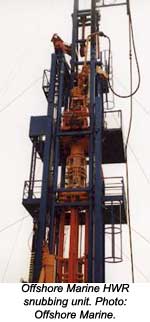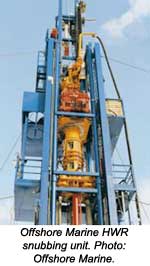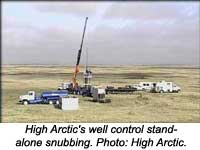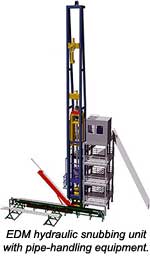Dangers of snubbing being mitigated by changing well control technology & applications

By John Murphy, Houston
To most longtime oil and gas field professionals, the word "snubbing" means trouble. It means a well somewhere is dangerously close to being out of control. "Everyone connected it with that forever," said Cudd Pressure Control vice-president, Ron Jackson. "Twelve to fourteen years ago a snubbing unit was the last thing you wanted to see come on your location."
 Snubbing units employ powerful hydraulic jacks, a power unit, and a crew work basket placed like a crow's nest high above the wellhead to force tubing or casing into a pressurized wellbore. It was a practice traditionally performed when a well could not be killed as would on occasion happen during drilling operations when an unexpected influx of gas invaded the wellbore.
Snubbing units employ powerful hydraulic jacks, a power unit, and a crew work basket placed like a crow's nest high above the wellhead to force tubing or casing into a pressurized wellbore. It was a practice traditionally performed when a well could not be killed as would on occasion happen during drilling operations when an unexpected influx of gas invaded the wellbore.
"[Snubbing units] are used in situations such as when you are off bottom with drill pipe and you take a kick in the hole, particularly in an oil mud where the kick is not going to migrate so you have to get the pipe back to bottom," explained Larry Flak, Engineering Manager of well control specialists and well firefighters, Boots & Coots.
Once the kick is under control, that is being flowed harmlessly to a pipeline or flare in what is often referred to as a diverted blowout, the drill pipe must be sent back to bottom before the crew can regain complete control. It is the classic snubbing unit task because often the upward pressure of the flowing well is greater than the downward force created by the available drill pipe weight.
"If you are pipe light, meaning you don't have enough weight for the drill pipe to combat the pressure, you may have to get a snubbing unit rigged up on the well to push it back in the hole because it won't fall."
 But times and job descriptions have changed for snubbers. Very much the way underbalanced drilling has gone from a situation to be avoided at all costs, snubbing operations designed to move pipe in and out of the hole while under pressure are now more often planned events than reactions to a dangerous situation threatening lives and property.
But times and job descriptions have changed for snubbers. Very much the way underbalanced drilling has gone from a situation to be avoided at all costs, snubbing operations designed to move pipe in and out of the hole while under pressure are now more often planned events than reactions to a dangerous situation threatening lives and property.
"With snubbing you have the ability to work on the well without killing it with heavy fluid that can be damaging to the formation," Jackson said. "So we can do workovers and completions without killing the well."
So popular has the practice become that Jackson estimates more than 80% of all snubbing jobs performed today are planned workovers, completions, or other type well interventions performed to protect the formation from fluid damage.
"Well control [snubbing] activities are very unusual," said Flak. "If [snubbing companies] had to depend on diverted blowouts to earn a living today, they would go bankrupt."
Offshore, doing a workover operations with a snubbing unit rather than a traditional rig is referred to as a "hydraulic workover", likely because of the old connotations industry veterans associate with the term snubbing. In the US Gulf of Mexico, it has become a common practice for the same reason underbalanced drilling has become popular in many onshore applications—re-entering depleted or partially depleted reservoirs.
 "A lot of customer focus in the past few months has been on production areas and going back in and enhancing production without hurting the producing formation," said Cudd's Mike Audrisch. He says the equipment and 70 employees gained in a recent snubbing company acquisition are all in the field. "We are looking for more employees. We and our competition are all working full tilt."
"A lot of customer focus in the past few months has been on production areas and going back in and enhancing production without hurting the producing formation," said Cudd's Mike Audrisch. He says the equipment and 70 employees gained in a recent snubbing company acquisition are all in the field. "We are looking for more employees. We and our competition are all working full tilt."
While avoiding damage to older formations is a prime driver of the proliferation of hydraulic workovers, Jackson says the growing popularity of underbalanced drilling just naturally raises demand for underbalanced completions. "Brand new wells are good candidates [for snubbing completions] because they don't have any damage yet," he said. "A lot of wells are drilled underbalanced with a little positive flow. But just because you drilled underbalanced, if you can't complete it underbalanced you really haven't accomplished as much as you might. We can run casing, cement, and perforate underbalanced and never hurt the formation. We can run up to 13-in. casing and handle a hook load of 600,000 pounds."
Snubbing's reputation as a dangerous way to make a living, say today's proponents of the process, has also been mitigated by changing technologies and applications when indeed the call does come for a well control situation. Much as operators now routinely drill in a situation once considered highly dangerous, so have they come to view completions and workovers done under pressure as not only safe, but as optimum and even routine under the proper circumstances and when properly planned.

"We have gotten better at everything we do," Jackson said. "We have better programs, for example, to calculate the collapse and buckling of the tubing being snubbed in and better [personnel] escape parameters. And today the bulk of the work is not done in ultra-high pressure. Like underbalanced drilling we are planning for the it and controlling the pressure."
As with so many older technologies, computer software is being brought to bear on the planning and executing of snubbing operations. The most critical factors in snubbing is knowing how much pipe can be "grabbed" and pushed in the hole at a time without buckling and how much collapse and burst pressure that pipe can handle. Cudd is in the midst of refining their proprietary program to better define those numbers and will possibly make them commercially available in the future.
"If you are on a well with 5,000 psi, and you are injecting tubing into it, you have to know the maximum unsupported length [of tubing] you can stuff in at a time and the forces exerted on the tube," said Jackson, explaining the theory behind the computer program. "You put in all the known parameters such as type of unit and power pack size, and it tells you the hydraulic settings and the maximum [length of tubing] you can take."
 Besides the ability to protect the formation during workover or completion operations, hydraulic workover units can offer such significant economic advantages that they are often used even when the well is not pressured. "Onshore, because you are competing with standard workover, snubbing units are used for workovers on wells that you don't want to kill and damage the formation or for some reason are difficult to kill," Flak said. "But offshore, hydraulic workovers are done with and without pressure on the well because they are cheaper and faster to rig up than a platform rig or a jackup that is cantilevered over the platform. And today it is sometimes hard to find a workover unit offshore when you need one. So the economics work offshore whether you want to kill the well or not."
Besides the ability to protect the formation during workover or completion operations, hydraulic workover units can offer such significant economic advantages that they are often used even when the well is not pressured. "Onshore, because you are competing with standard workover, snubbing units are used for workovers on wells that you don't want to kill and damage the formation or for some reason are difficult to kill," Flak said. "But offshore, hydraulic workovers are done with and without pressure on the well because they are cheaper and faster to rig up than a platform rig or a jackup that is cantilevered over the platform. And today it is sometimes hard to find a workover unit offshore when you need one. So the economics work offshore whether you want to kill the well or not."
In addition to the immediate savings on high-cost jackups, when working over a well under pressure, there are costs savings in heavy muds and their handling. (Heavy kill muds with exotic additives designed to protect producing formations are often expensive to recycle and transport in the environmentally sensitive offshore.) Also, rig up and down is faster than with traditional workover rigs and production can be brought back on line more reliably and quicker when muds need not be cleaned from the well bore first—an operation that can take several days.
While some of the traditional snubbing market such as wellbore fluids clean-out or spotting acid or cement in live wells, have in recent years become the province of coiled tubing, demand for the staid old units is likely to remain high. For one thing, CT units have size limits, snubbing units do not. Above about a 3 ½-in diameter, particularly offshore, their weight and space requirements are a liability. And CT is not available in production casing sizes, which are often the section operators are most intent on protecting from fluid invasion.
And finally, one of the most prolific areas of development in the world today, is in the older fields of the US Gulf of Mexico, where independent operators are re-entering partially depleted zones to recover hydrocarbons left behind by majors seeking bigger targets. The depleted nature of these zones means they are highly susceptible to fluid invasion damage during recompletion and workover operations, in many cases the least expensive, most efficient method for handling them: hydraulic workovers.
